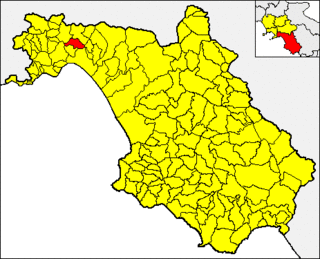
Baronissi is a town and comune in the province of Salerno in the Campania region of south-western Italy. It is home to a campus of the University of Salerno.

Felitto is a town and comune in the province of Salerno in the Campania region of south-west Italy. It is famous for fusilli, a kind of handmade pasta, and the annual Fusillo festival.

Laurino is a town and comune in the province of Salerno in the Campania region of southwestern Italy.

Montesano sulla Marcellana is a town and comune of the province of Salerno in the Campania region of south-west Italy.

Ogliastro Cilento is a town and comune in the province of Salerno in the Campania region of south-western Italy. As of 2011 its population was of 2,241.

Rofrano is a town and comune of the province of Salerno in the Campania region of south-west Italy. It is located in the southern Cilento. In 2015 its population was 1,539.

Vietri sul Mare is a comune (municipality) in the province of Salerno, in the Italian region of Campania. It is situated just west of Salerno, separated from the Port of Salerno by only a harbour wall. The town is known for its polychrome ceramics, a tradition since at least the 15th century, and is considered to be the gateway to the Amalfi Coast.

Stio is a town and comune in the province of Salerno in the Campania region of south-western Italy. As of 2016, its population was 872.

Cilento is an Italian geographical region of Campania in the central and southern part of the province of Salerno and an important tourist area of southern Italy.

Pruno is a forest in the Campania region of southern Italy. It is the largest woodlands of central Cilento region. The hamlets (frazioni) with this name are situated in the municipalities of Laurino, Valle dell'Angelo and Piaggine, and are considered a singular village.

Policastro Bussentino is an Italian town and hamlet (frazione) of the municipality of Santa Marina in the province of Salerno, Campania region. It is a former bishopric, now titular see, and has a population of 1,625.

Magliano Nuovo is a southern Italian village and hamlet (frazione) of Magliano Vetere, a municipality in the province of Salerno, Campania. As of 2011, its population was 334.

Case del Conte, sometimes also spelled Casa del Conte, is a southern Italian village and hamlet (frazione) of Montecorice, a municipality in the province of Salerno, Campania. As of 2009 its population was of 235.

Casalsottano, also spelled Casal Sottano, is a southern Italian village and hamlet (frazione) of San Mauro Cilento, a municipality in the Province of Salerno, Campania. In 2011 it had a population of 397.

Capitello is a southern Italian village and hamlet (frazione) of Ispani, a municipality in the province of Salerno, Campania. As of 2009 its population was of 626.

Caprioli is a Southern Italian village and hamlet (frazione) of Pisciotta, a municipality in the province of Salerno, Campania. As of 2009 its population was of 121.

Villammare is a southern Italian village and the only hamlet (frazione) of Vibonati, a municipality in the province of Salerno, Campania. As of 2009 its population was of 1,024.

Licosa is a southern Italian village and hamlet of Castellabate, a municipality in the province of Salerno, Campania. As of 2009 its population was of 82.

Piano Vetrale, also shortened as Vetrale or Piano, is a southern Italian village and hamlet (frazione) of Orria, a municipality in the province of Salerno, Campania. As of 2011, its population was of 475.

Sava is a southern Italian village and hamlet (frazione) of Baronissi, a municipality in the province of Salerno, Campania. With a population of 4,153 (2009), it is the most populated hamlet of its municipality.





















